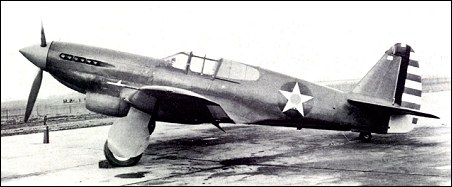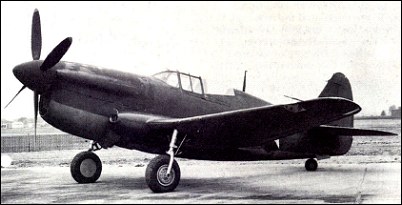 |
Curtiss XP-601941 |  |
| FIGHTER | Virtual Aircraft Museum / USA / Curtiss |
 |
The P-60 designation applies to a family of widely different Curtiss fighters, each reflecting the urgency of the builder's unsuccessful effort to develop a P-40 replacement. Though only four airframes carried out the P-60 programme, no fewer than nine designations were involved: XP-60, XP-60A, YP-60A, P-60A, XP-60B, XP-60C, XP-60D, XP-60E and YP-60E. The programme ran from early 1941 to December 1944 and was Curtiss's last gasp in the propeller-driven fighter field, an ambitious but unfocussed effort which involved several engines, propellers, and canopy configurations. The XP-60 was a low-wing, conventional-gear fighter developed from the uncompleted XP-53 but powered by a 969kW Packard V-1560-1 licence-built Merlin, belatedly determined by the USAAF to be the best engine available in 1941. This airframe flew on 18 September 1941. With all Merlin-related resources soon committed to the P-51 Mustang programme, the USAAF then decided to employ the ubiquitous 1062kW Allison V-1710-75 in planned production-model P-60s. On 31 October 1941, 1,950 such fighters were ordered. Soon, however, it became evident that Curtiss' Buffalo, New York, plant could be more usefully employed building P-47G Thunderbolts and the contract was cancelled. Three XP-60A airframes were tested with the Allison powerplant before being re-engined. The proposed YP-60A, which would have had a 1491kW Pratt & Whitney R-2800-10 radial, was another variation which did not result in a finished airframe. The XP-60B was to have been the original machine with a shift from Merlin to Allison power but apparently this change was never made. The XP-60C, converted in 1943 from one of the three Allison test ships, employed the R-2800 radial. This was the sole example tested with Curtiss Electric contra-rotating propellers. The XP-60D was the original machine retaining its Merlin but with enlarged tail surfaces and other minor changes. The XP-60E was another R-2800 radial-powered variant. Last in the series was the YP-60E, another conversion, again R-2800 radial-powered but now uncamouflaged and with bubble canopy, the result being formidable competition to the Curtiss P-40Q for the claim of most beautiful fighter ever built. In November 1942, the US Army ordered 500 Pratt & Whitney-powered P-60 fighters but the production contract was soon set aside in favour of other priorities. The P-60 programme ended by mid-1944, the last airframe being scrapped on 22 December 1944.
|  COMPANY PROFILE | ||||||||||||||||||||||||||||||||||||||||||||||||||||
 |

|


